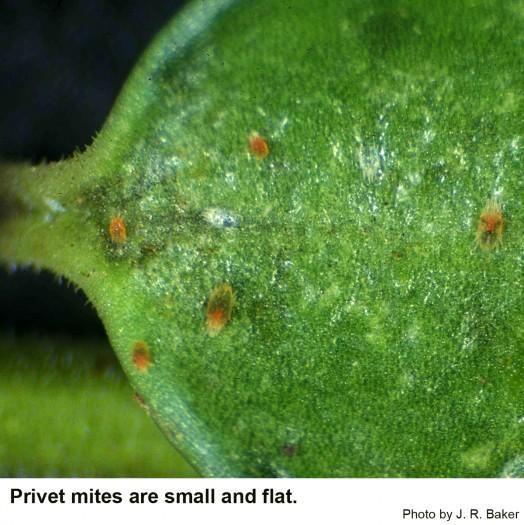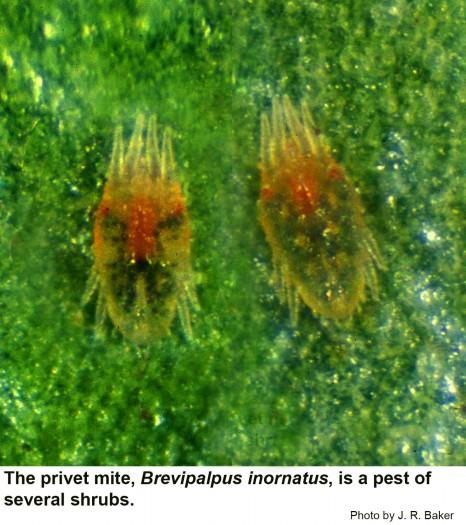Description and Biology
The privet mite, Brevipalpus obovatus, is a member of the family Tenuipalpidae, commonly called false spider mites or flat mites. It feeds on a variety of woody ornamental plants. The privet mite is very small (0.3 mm), reddish, flat, and strongly textured on top (if you have a microscope to admire the texture). Flat mites cause the same sort of damage that spider mites do except that flat mites do not spin silk and their damage accrues more slowly. Female flat mites lay eggs that take 20 to 21 days to hatch at room temperature. Larvae hatch from the eggs and feed for about two weeks before molting into protonymphs. After 15 days of feeding, the protonymphs molt into deutonymphs. Two weeks later, the deutonymphs molt into adult mites. Development is slower outdoors in cold weather. We have four to six generations of privet mites per year (whereas spider mites have 18 to 36 generations per year).
Host Plants
The privet mite has been reported from Andrachne sp., Barringtonia racemosa, Bignonia sp., blackberry, boxwood, Callistemon sp., Camellia sinensis, Chamaemelum sp., chrysanthemum, Citharexylum quadrangulare, cotton, cucumber, elephant ear, English ivy, Epimedium, Eriobotrya japonica, fig, Gerbera sp., golden rod, grape, Hibiscus, Kunzea baxteri, lemon, Ligustrum spp., mints, oregano, persimmon, Phoenix, Phytolacca sp., Pittosporum undulatum, Rhododendron, Solanum esculentum, S. tuberosum, thyme, tulip bulbs, Verbena bonariensis, and Viburnum. Privet mites cause the same sort of damage that spider mites do except that flat mites do not spin silk. With their needle-sharp mouthparts, false spider mites puncture the epidermis of the host plant and suck out the juices. This causes a pale spot that may later turn brown. Infested shrubs slowly turn reddish-brown and appear to have "winter injury". This damage resembles that of spider mites but the onset of symptoms is much slower. In addition, privet mites are vectors of certain plant viruses.
Residential Recommendation
Flat mites have not been reported to be resistant to pesticides. Use one of the insecticidal soaps, a horticultural oil, or one of the pyrethroids as a thorough spray. These pesticides should be available in most plant shops and garden centers.
References
- Brevipalpus californicus, B. obovatus, B. phoenicis, and B. lewisi (Acari: Tenuipalpidae): a review of their biology, feeding injury and economic importance. Childers, C. C. et al. 2003. Exp. Appl. Acarol. 30(1-3):5-28.
- False Spider Mites. Frank, S. D. et al. 1997 (Revised). Entomology Insect Notes, NC State Extension Publications.
- Flat Mites of the World. Beard, J., R. et al. 2013 (Update). a portal to a variety of keys, images, and fact sheets.
- Host plants of Brevipalpus californicus, B. obovatus, and B. phoenicis (Acari: Tenuipalpidae) and their potential involvement in the spread of viral diseases vectored by these mites. Childers C.C. et al. 2003. Exp Appl Acarol. 30 (1-3):29-105.
- Extension Plant Pathology Publications and Factsheets
- Horticultural Science Publications
- North Carolina Agricultural Chemicals Manual
For assistance with a specific problem, contact your local N.C. Cooperative Extension Center.
This Factsheet has not been peer reviewed.
Publication date: Nov. 8, 2013
Revised: Oct. 11, 2019
Recommendations for the use of agricultural chemicals are included in this publication as a convenience to the reader. The use of brand names and any mention or listing of commercial products or services in this publication does not imply endorsement by NC State University or N.C. A&T State University nor discrimination against similar products or services not mentioned. Individuals who use agricultural chemicals are responsible for ensuring that the intended use complies with current regulations and conforms to the product label. Be sure to obtain current information about usage regulations and examine a current product label before applying any chemical. For assistance, contact your local N.C. Cooperative Extension county center.
N.C. Cooperative Extension prohibits discrimination and harassment regardless of age, color, disability, family and marital status, gender identity, national origin, political beliefs, race, religion, sex (including pregnancy), sexual orientation and veteran status.



